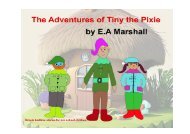Science Experiments to try at Home
Simple science experiments written by secondary students for primary students to do at home.
Simple science experiments written by secondary students for primary students to do at home.
You also want an ePaper? Increase the reach of your titles
YUMPU automatically turns print PDFs into web optimized ePapers that Google loves.
Warro! It is your turn now <strong>to</strong> be the teacher. Can you<br />
explain wh<strong>at</strong> has happened <strong>to</strong> the egg shell?<br />
DrM’s explan<strong>at</strong>ion<br />
Bouncy Egg<br />
Between the vinegar and eggshell, a chemical reaction occurs. The acid in<br />
the vinegar reacts with the calcium carbon<strong>at</strong>e in the eggshell. This<br />
reaction breaks down the eggshell. The reaction also makes carbon<br />
dioxide and if you look <strong>at</strong> the egg carefully you will see bubbles on the<br />
eggshell as it is reacting with the vinegar. The membrane underne<strong>at</strong>h<br />
does not react, and it will be left once all the eggshell has gone, making<br />
the egg bouncy. It is very delic<strong>at</strong>e and will break if you prod it <strong>to</strong>o much.<br />
Peer Review<br />
Hi! I am the Christkindl from Germany and I<br />
deliver presents during advent <strong>to</strong> children in<br />
central Europe.<br />
I set up lots of different coloured eggs and it<br />
worked well.<br />
My question is: Wh<strong>at</strong> other liquids can you use <strong>to</strong> react with the egg<br />
shell?<br />
Wh<strong>at</strong> is your question?<br />
62














